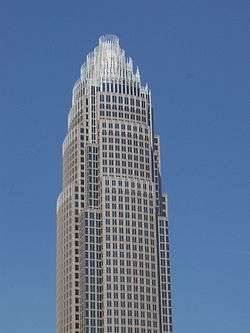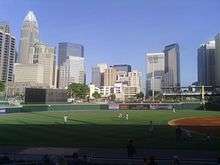Charlotte center city
| Charlotte Center City | |
|---|---|
| Neighborhood of Charlotte, North Carolina | |
| Nickname(s): Historic Downtown / Uptown | |
| State | North Carolina |
| County | Mecklenburg |
| City | Charlotte |
| Council districts | 1, 2 |
| Neighborhood Profile Areas (NPA) | 340, 341, 342, 384 |
| Area | |
| • Total | 5.5 km2 (2.14 sq mi) |
| Population (2016)[1] | |
| • Total | 16,500 |
| • Density | 3,000/km2 (7,700/sq mi) |
| Zip Code | 28202, 28204, 28206, 28208 |
| Area code(s) | 704, 980 |
| Website | www.CharlotteCenterCity.org |
| Quality of Life Dashboard | |
Charlotte Center City (commonly referred to as Uptown) is the central area of Charlotte, North Carolina. The area is split into four neighborhoods (wards) by the intersection of Trade and Tryon Streets.
Several Fortune 500 companies have their headquarters in the district, including Bank of America, Duke Energy, and the east coast operations of Wells Fargo. Athletic and event facilities located in Center City include Bank of America Stadium, Spectrum Center, BB&T Ballpark, and the NASCAR Hall of Fame. Museums, theaters, hotels, high-density residential developments, restaurants, and bars are heavily concentrated in the Center City, with over 214 restaurants and 50 nightspots.[2]
Central Charlotte
Charlotte Center City is referred to as "Uptown" by some locals, although the term "Downtown" is understood and used by native Charlotteans since it references the same area of the city.
Origins
There is some confusion brought about by the use of the terms "Uptown" and "Downtown" for Charlotte's center city area. The term "Up-Town" referring to the geographic location of Tryon and Trade Street and was recorded as early as 1895 in the Charlotte Observer but fell out of use around 1929 for reasons unknown. The term "Downtown" was commonly used up until the mid-1970's by residents, media, and city leaders for the Center City. In 1973, a massive campaign was launched by local businessman Jack Wood to revamp the image of the downtown area and embrace the historic and arguably uniquely Charlotte term "Uptown" by reintroducing it to the general public. In September of 1974 Charlotte City Council passed an official proclamation that said "The heart of Charlotte should be now and forever more be known as Uptown Charlotte."[3] On February 14, 1987, the Charlotte Observer began using the term "Uptown" as a way to promote a more positive upbeat image of the Center City area.[4] School teachers were provided with "historical" documents justifying use of the term to teach to students.[5]
Character
Charlotte's center city area (including South End) employs 113,800 people, hosts more than 18 million visitors a year, and is home to 25,970 people.[6]
Major streets
Tryon Street

Tryon Street is a major north-south street of Charlotte, North Carolina. It traverses through the center of Downtown Charlotte and is the address for some of the city's tallest buildings, such as the Bank of America Corporate Center and Hearst Tower. U.S. Route 29 and North Carolina Highway 49 are signed along portions of Tryon Street (although they both deviate onto Graham Street through Uptown). The road is divided into two segments at its intersection with Trade Street: North Tryon Street and South Tryon Street. Likewise, Tryon Street divides Trade Street into east and west. The Trade and Tryon intersection serves as the dividing point for the city's first four wards. The street was named after William Tryon, governor of the Province of North Carolina from 1765 to 1771.
Entering the Charlotte city limits from the north, US 29's street name changes from Concord Parkway to North Tryon Street. US 29 and Tryon Street continue southwest through the University City neighborhood, passing by the Verizon Wireless Amphitheater Charlotte, intersecting with Interstate 485 (North Carolina), and passing through the University of North Carolina at Charlotte.
South Tryon Street terminates at the Charlotte city limits at the Steele Creek neighborhood, where it changes to York Road. NC 49 continues west to Lake Wylie, South Carolina, where it becomes Charlotte Highway.
Building which have a Tryon Street address include:
Trade Street
Trade Street is the major east-west street that divides the northern and southern wards in the city of Charlotte, North Carolina. The following towers have a Trade Street address:
Wards
Center City Charlotte is divided into four neighborhoods, or "wards", by the intersection of Trade and Tryon Streets.[7]
The first ward
First Ward lies directly to the east of the intersection of Trade and Tryon. It is that quadrant bounded by North Tryon on the northwest and East Trade on the southwest.
Once considered one of the most dangerous areas in Charlotte, the first ward has become one of the more desirable because of revitalization under a HUD HOPE VI grants with many new developments are under construction. The award winning Center City Building which houses the uptown campus of the University of North Carolina at Charlotte is in the first ward. The Center City Building is part of an urban village project being developed by Levine Properties. The urban village includes a 4-acre (16,000 m2) park, which was completed in December 2015, 450,000 sq ft (42,000 m2) of office space, 2,700 residential units, 250 hotel rooms, 250,000 sq ft (23,000 m2) of retail space, and 450,000 sq ft (42,000 m2) of civic space. Current attractions include the Main Library, the Spirit Square portion of the North Carolina Blumenthal Performing Arts Center, ImaginOn Children's Learning Center, Levine Museum of the New South, the Spectrum Center (home of the Charlotte Hornets). On Tryon at Sixth Street, one of Charlotte's historic buildings is being preserved and connected to a new condo project called "Encore."
.jpg)
Second Ward
The second ward lies directly to the south of the intersection of Trade and Tryon. It is the quadrant bounded by South Tryon on the northwest and East Trade on the northeast.
It is the location of Charlotte's "Government District" and is the site of the NASCAR Hall of Fame. The second ward used to be the location of the predominantly black neighborhood, Brooklyn, before an urban renewal project took place. Today, we find EpiCentre, a mixed-use entertainment and retail complex; the Charlotte Convention Center; the Victorian Gothic style St. Peter's Catholic Church; The Green, a downtown mini-park; and the Harvey B. Gantt Center for African-American Art+Culture.
Third Ward

The third ward lies directly to the west of the intersection of Trade and Tryon. It is the quadrant bounded by South Tryon on the southeast and West Trade on the northeast. It is the location of the Knight Theatre, the Mint Museum, and the Bechtler Museum of Modern Art.
Center City's third ward is a diverse "streetcar neighborhood," home to the Carolina Panthers' Bank of America Stadium and Gateway Village. Gateway Village, one of the state's largest mixed-use developments, is 1,500,000 sq ft (140,000 m2) in size, and home to offices, shops, restaurants, entertainment venues and over 500 housing units.[8] Wachovia's First Street Project, comprises cultural, office, residential, and open space. Johnson & Wales University campus is in Center City, while the Mecklenburg County's Parks and Recreation Department has unveiled plans for an urban park in the district.Multiple condominium high rise towers have begun or are ready to begin construction. Plans are also underway to construct a $200 million transportation hub along the Norfolk Southern Railway called the Gateway Station.The Gateway Station will house the Greyhound bus stop, the Amtrak station, the LYNX Red Line and LYNX Silver Line, and a CATS bus hub.
BB&T Ballpark opened in 2014 as the home of the Charlotte Knights. Directly across the street is Romare Bearden Park, which opened in September 2013.
Fourth Ward
The fourth ward lies directly to the north of the intersection of Trade and Tryon. It is that quadrant bounded by North Tryon on the southeast and West Trade on the southwest.
It is mostly residential and has many stately Victorian homes. It is an official historic district, and is the location of Old Settlers' Cemetery and the three-acre Fourth Ward Park.
Center City schools and libraries
Higher learning
- Johnson and Wales University
- University of North Carolina at Charlotte North Charlotte
- Johnson C. Smith University
- Central Piedmont Community College
- Queens University of Charlotte
- Gordon-Conwell Theological Seminary
- Reformed Theological Seminary
- Southern Evangelical Seminary
- Union PSCE (Presbyterian Seminary)
Libraries

Charlotte Center City is served by two branches of the Public Library of Charlotte and Mecklenburg County now known as Charlotte Mecklenburg Library. The Main library is located on North Tryon Street.[9]

ImaginOn: The Joe and Joan Martin Center is located on east Seventh Street.[10] ImaginOn is a collaborative venture of Charlotte Mecklenburg Library and the Children's Theater of Charlotte. The library provides services, books, CDs, DVDs and homework support for children and teens. ImaginOn contains the McColl Family Theatre and the Wachovia Playhouse, venues used by the Children's Theater for their performances.
Parks
In August 2013, the city opened Romare Bearden Park which is a 5.4 acre public park located at 300 S. Church Street.
Headquarters
Some companies based in Center City include:
- Bank of America
- BBVA Compass
- Wells Fargo
- BB&T
- Ally Financial
- Duke Energy
- AT&T
- The Westin Charlotte
- Center City Suites | Furnished Corporate Apartments
- The Ritz Carlton Charlotte
- Hyatt House
- Hilton Charlotte
- Embassy Suites
- Omni Hotel
- Residence Inn by Marriott
- Marriott Charlotte
- Courtyard by Marriott
- Hampton Inn
- SpringHill Suites
- Kimpton Tryon Park Hotel
- DoubleTree
- Aloft
- Crowne Plaza
- Holiday Inn
- Hilton Garden Inn
- AC Hotel
- InterContinental Hotel (under construction)
- EVEN Hotels
References
- ↑ "2016 State of the Center City". Charlotte Center City Partners. Retrieved 26 January 2016.
- ↑ http://www.bizjournals.com/charlotte/blog/queen_city_agenda/2014/02/retail-office-towers-hotels-top-uptown-charlottes.html?page=2
- ↑ http://www.wfae.org/post/faq-city-why-downtown-charlotte-called-uptown#stream/0
- ↑ "Charlotte-Mecklenburg Story: History Timeline: 'Down' Becomes 'Up'". cmstory.org Web Site. Public Library of Charlotte and Mecklenburg County. Retrieved 2015-09-28.
- ↑ [ Proclamation Designating Central Shopping and Business District as 'Uptown Charlotte' ] by City of Charlotte Mayor John M. Belk; September 23, 1974; Note:This claim needs a reliable source and link
- ↑ "2016 State of the Center City". Charlotte Center City Partners. Charlotte Center City Partners. Retrieved 26 January 2016.
- ↑ "Charlotte Center City Map – 4 Wards".
- ↑ "Post Gateway Apartments: Charlotte Community & Amenities". www.postproperties.com. Retrieved 2016-03-28.
- ↑ "The Main Library of the Public Library of Charlotte and Mecklenburg County". Retrieved 2008-10-25.
- ↑ "ImaginOn: The Joe and Joan Martin Center". Retrieved 2008-10-25.
External links
Official websites
- Official website Charlotte Center City
- Living Uptown Charlotte
